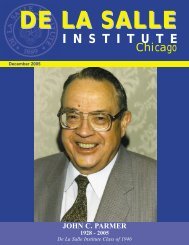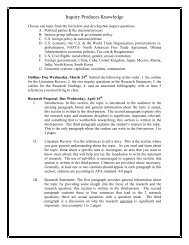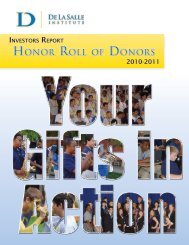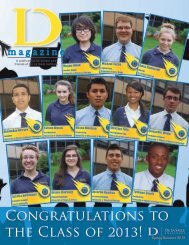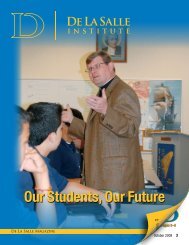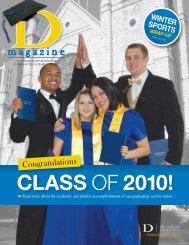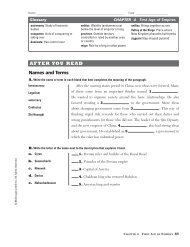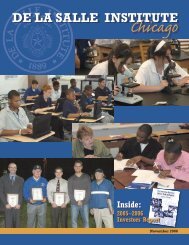Winter 2013 Issue - De La Salle Institute
Winter 2013 Issue - De La Salle Institute
Winter 2013 Issue - De La Salle Institute
- No tags were found...
Create successful ePaper yourself
Turn your PDF publications into a flip-book with our unique Google optimized e-Paper software.
ACADEMICSThe New Illinois Learning StandardsIncorporating the Common CoreThe name chosen for the recently adopted common coreis The New Illinois Learning Standards Incorporatingthe Common Core (NILSICC). Illinois has in placeeducational standards for early childhood, fine arts, foreignlanguage, physical development and health, science,social emotional, and social science. The recently adoptedcommon core for English <strong>La</strong>nguage Arts and Math is nowincorporated into the full set of Illinois Learning Standardsfor K-12 education. The goal is to better prepare Illinoisstudents for success in entry-level, credit-bearing academiccollege courses and in workforce training programs withina competitive global economy.Why New Standards?• Our expectations for what students must know andbe able to demonstrate were different in 1997 whenIllinois adopted the current standards.• The new standards aim to provide clear, consistentacademic benchmarks with “fewer, clearer andhigher” academic standards for essential learningand skills. The standards were developed whileconsidering the standards of top performing countriesand the strengths of current state standards.• The 2010 state standards provide benchmarks foracademic progress (skills and knowledge) thatstudents should have at the conclusion of each gradelevel. This will allow teachers to establish the bestapproach to help their students meet those standards.• Students and parents will clearly understand theknowledge students are expected to attain each year.The Standards:• Are aligned with college and work expectations;• Include rigorous content and application of knowledgethrough high-order skills;• Build upon strengths and lessons of current statestandards;• Are informed by other top performing countries, sothat all students are prepared to succeed in our globaleconomy and society; and• Are evidence-based.<strong>De</strong> <strong>La</strong> <strong>Salle</strong> <strong>Institute</strong>’s Response<strong>De</strong> <strong>La</strong> <strong>Salle</strong> <strong>Institute</strong> is finishing up a thorough, three-yearreview of the college preparatory academic curriculumalready in place. The two previous school years were spentreviewing the freshman and sophomore curriculum intheir entirety, while this year brings a study of the juniorcurriculum. Led by teacher facilitators, a curriculummap is developed for all of the core classes, as well aselectives, and is linked to the NILSICC. The end result is acomprehensive binder giving the teachers a clear idea as towhat must be accomplished and taught throughout the yearin their particular academic area. Included in the binder aresample class syllabuses, tests, quizzes, and projects fromwhich the teachers can draw. The review wraps up eachyear with a presentation to the Curriculum Committee,Board of Directors and approval by the administration.It has been an incredible, thoughtful and detailed processthat has shaped the future of <strong>De</strong> <strong>La</strong> <strong>Salle</strong>’s academicstandards. The <strong>2013</strong>-2014 school year will wrap-upwith the exam of the senior curriculum, in time for fullimplementation of the new core curriculum in 2014-15,which is the statewide target date.Resources:www.isbe.net/common_corehttp://ocs.archchicago.org/AcademicExcellence/CommonCoreStateStandards.aspxAcademics 5



